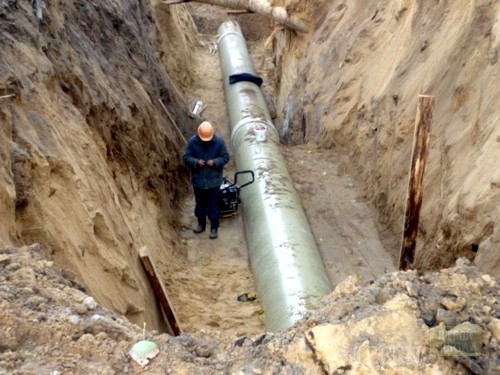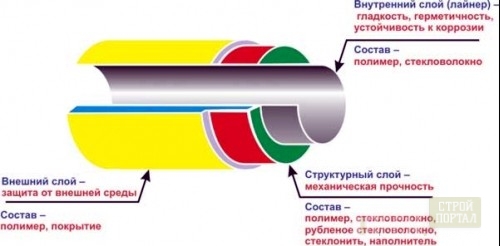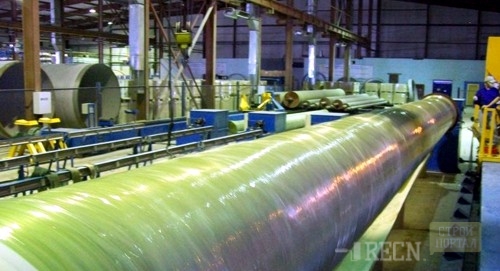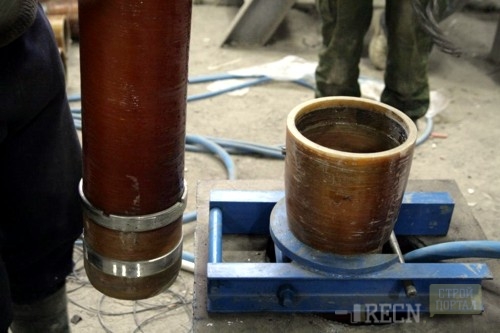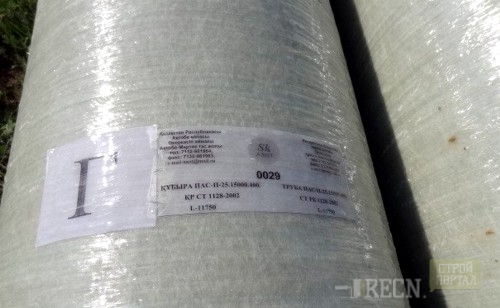
Fiberglass pipes: features and installation Building materials

Only, forty-fifty years ago, fiberglass pipes were not familiar with mankind. But at the end of the seventies of the last century, Western scientists managed to solve the problem of corrosion of metal pipes due to the use of new materials. Then fiberglass pipes began to be actively used.
Content
Fiberglass pipe is made of composite material - fiberglass. Depending on the type of resin, the number and types of used reinforcing materials, as well as production technology, mechanical and physical properties of the product may vary.
Application area
Popular pipe manufacturer of fiberglass - Amiantit has released a trial batch of pipes in the late sixties of the last century. For dozens of years, the manufacturer managed to enter the global level and now the pipes from fiberglass (GRP) deserve attention, due to quality and reliability. This is due to the fact that pipes are manufactured by a special method - continuous winding over the helix. As a result, they are not exposed to corrosion and become very resistant to acids and medium. In addition, in contrast to standard metal pipes, fiberglass pipes are easy to circulation - weight of products many times less heavy metal. Therefore, if there are doubts what to buy pipes are fiberglass or traditional metal, most companies choose durable and practical materials for laying high-freewater highways.
In just a forty-fifty years, the leading company of fiberglass, the leading pipeline of pipes from fiberglass managed to take not only the leading position, but also to become a step above.
The scope of pipes from fiberglass is quite wide, they can be used to lay the system of sewage and drainage, as well as apply for fire extinguishing, transportation of drinking and technical water. You can lay pipes on power plants and with the withdrawal of any kinds of waste.
In addition, fiberglass pipes are widely used when laying almost any kind of communications:
- main lines;
- sewage networks of any destination;
- water supply;
- gaskets of gas and oil pipelines.
The popular plants of Amiantit in the production of their products take into account the interests of each consumer - you can purchase pipes from fiberglass of different diameters, lengths and designs, as well as additional components and fittings. In addition, the production process is established in such a way as to satisfy the requirements of any buyer and make pipes by individual order.
The diameter of the standard fiberglass pipe ranges from a hundred to three thousand seven hundred millimeters, and the length can reach eighteen meters. Use such pipes is allowed in six pressure grades and in three - by strength. Thanks to these indicators, it is safe to note that fiberglass pipes have not only efficiency. Also marked high durability of products.
Main advantages
Most pipes are manufactured according to the standard scheme - fiberglass threads are screwed onto a solid frame in continuous mode. The thread is reinforced by a special composition of fiberglass and impregnated with a resin mixture, crushed fiberglass and sand. Thanks to such technology, pipes can be served for more than fifty years. It is not possible to talk about a longer service life, because from the moment of the release of the first batch of products passed only half a century. But, according to experts, such pipes can serve much longer.
What are the pluses of fiberglass pipes:
- long service life;
- simple installation. Connect pipes very easily with the help of an additional coupling compound. Use welding and control the quality of the connecting seam is not necessary, which allows you to significantly save time and means when installing;
- ease. If we compare the weight of the tube of standard sizes with a similar pipe, but consisting of high-quality steel alloy, the pipe from fiberglass will be easier for eighty percent;
- does not rust and perform additional actions to combat corrosion do not have to;
- the material is resistant to wear and is not rotated by the effects of aggressive components;
- installation can be performed both in winter and in summer - temperature changes do not have a significant effect on the installation;
- the price of a fiberglass pipe does not depend on the cost of metal and energy;
- meet environmental standards;
- fiberglass withstands temperature fluctuations - from minus sixty-five to plus a hundred and fifty-five degrees Celsius.
When choosing fiberglass pipes, you must consider the following:
- Pipes made of fiberglass should not contain extraneous enclosures.
- The surface should be smooth and smooth.
- Pay attention to the edge of the pipes - it should be smooth and smooth, without cracks and bundles.
- Pipes can be poured, drilled, accurate and milling, and the surface of the quality product under mechanical exposure is not subjected to bundle, the formation of chips and cracks.
The life of the fiberglass pipeline is increased eight times (if compared with the metal alloy pipeline), so you can not worry about corrosion and other coating protection methods.
Views
To increase product strength, manufacturers have developed several types of fiberglass pipes that can be used in various fields of activity. So, to achieve the strength of fiberglass pipe compounds, various types of cutting reinforcement have been developed. In addition, to increase the strength of the groove wedge on the cut can be possible due to the strengthening of the side edge of Kliniev. Thanks to this technology, such pipes are allowed to apply for rotary wedges.
By cross section, fiberglass pipes are divided into such types:
- Complete cross section. Its form can be different - in the form of a rectangle, a circle, trapezoid, semicircle and segment.
- Cross section "Ring". Pipes with such a cross section are made only under the order, all the nuances with the customer are pre-ordered.
During the production of fiberglass pipes, different types of resins can be used. To enhance the strength of the product, an orthoptalis, isophthartic and bisphenolic resins are added in the manufacture of products, which increases the resistance to alkaline solutions, salts and acids.
Each type of pipe can be divided into two types: a single-layer tube and multilayer. The first consists of a composite material and is made by winding technology with a wet method. The composition of the pipe prevails epoxy resin and the binding material - glass beam. Multilayer pipes are "closed" into an additional shell (one or more) of durable polyethylene. Each layer is associated with the previous one by polymerization at high temperature, which allows to increase the durability of the pipe to different influences.
What are passes of fiberglass pipes
Along with the advantages, fiberglass pipes have a number of shortcomings. Thus, when operating pipes from fiberglass, such features were identified: with a substantial load across the fibers of the product marked low resistance to cracks, which does not allow the use of pipes when laying oil pipelines. This can be avoided if enhance the sealing of pipes from the inside using a special corrugated sealing layer.
Installation of fiberglass pipes
Installation of pipes from fiberglass can be performed in different ways.
Consider the most accessible and efficient:
- Standard Tube Tube Tube can be easily mounted. Installation technology does not differ from the laying of polyvinyl chloride sewer pipes. When installing, you should adhere to a specific sequence - insert one pipe into the extension (socket) next.
- Compound of pipes with flanged method. Each pipe on the end is equipped with a special flange (ring) with holes for fastening elements.
- Coupling connections are used for pipes of any species. You can additionally install removable compounds or designs without subsequent disassembly (use of adhesive materials).
- Compound of the type "buckel", the type of coupling mounting. This is a special device, with which you can easily dock pipes, and then combine their fasteners (for example, bolts).
- In some cases, the use of screw and threaded compounds of plastic pipes is allowed.
Marking
Depending on the coating and destination, each pipe has a certain marking. It is not difficult to understand these designations. Products intended for laying water pipes, drinking drinking and shop water indicate the letter "P". The marking indicates that fiberglass pipes can be used for any water pipes, including drinking water supply.
The letter "g" - pipes are allowed to be used in hot water supply systems, provided that the temperature of water or other energy carrier will not exceed seventy-five degrees.
"X" - the designation of this letter suggests that the pipes can be stacked for transporting gases and other chemically active substances.
If abrasive inclusions are present in the liquid, such substances can be poured through pipes with marking "A".
Universal pipes made of fiberglass are marked with "C", in addition, products are resistant to acid.





